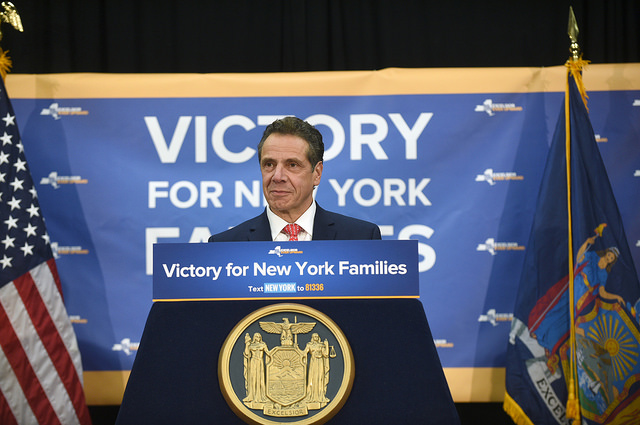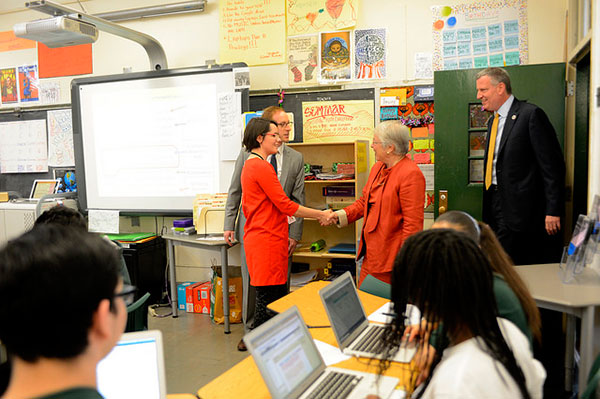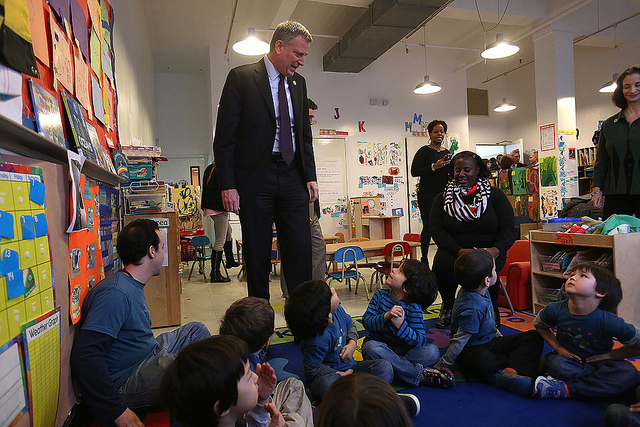Governor Cuomo’s Workforce Investment Plan is a Promising Start

Gov. Cuomo (photo: Kevin P. Coughlin/Governor's Office)
In a time when more and more training and credentialing is necessary to enter the labor market, Governor Cuomo’s workforce development proposal included as part of his 2018 State of the State symbolizes an important recognition that our economy depends on having a skilled and qualified workforce to meet the demands of tomorrow.
The sense of urgency can be found in the realities that today’s young adults are facing in entering the labor market. Seventeen percent of, or 136,000, 18-to-24 year olds in New York City are out of school and out of work. As the economy continues to redefine itself, young adults are increasingly turning to part-time, gig-like employment opportunities to string together income. Many young adults were pushed to earn a college degree—as part of the American rite of passage—only to graduate with tens of thousands of dollars in student debt and entering a labor market with historically low-wages. Consequently, today’s young adults have significantly less income and wealth accumulation than what their parents were making when they were young adults.
The challenges young adults face today are, in part, reflective of the dire need to reimagine how we are preparing young adults to launch their lives with a family-sustaining career. This means ensuring they have equitable access to postsecondary training and credentialing while meeting labor market demand. It’s time for New York State to better leverage its strong and growing economy by building a 21st century workforce development system necessary to adequately prepare rising generations to participate in a constantly changing and increasingly competitive global context.
To be clear, this is not to be confused with the phenomenon of pushing every young person to go straight from high school into a four-year bachelor’s-degree program—although everyone should have access to pursue a college degree if they desire. In fact, according to the Georgetown University Center on Education and the Workforce, 42 percent, or 1.7 million, New York State residents without bachelor’s degrees have good, blue-collar jobs earning an average of $59,000 a year. This directly challenges the mainstream narrative that every young person needs a four-year degree and makes clear the need to invest in a 21st century workforce development system that can help meet the needs of employers in growing industry sectors, without needing a four-year degree.
Governor Cuomo’s proposal to add $175 million to support workforce development efforts, establish a statewide workforce development office, design a data system, and establish a one-stop shop for job seekers and employers is a victory in and of-itself. However, we must remain diligent to ensure his vision becomes the reality New Yorkers need it to be.
The proposed $175 million of funding through the Regional Economic Development Councils is a much needed and timely investment—especially given the rapidly changing nature of the economy. Critical to the success of Governor Cuomo’s bold proposed investment is to ensure that these resources are structurally permanent dollars the workforce, education, and economic development systems can depend on year-to-year in order to adequately train New Yorkers to meet labor market demand.
Because actual funding for the workforce system has declined significantly over the last decade—despite the increasing need for more industry-specific training and credentials—some of the initial resources should be used to build up and modernize the existing workforce development infrastructure. This will allow the workforce development system the opportunity to partner with employers and industry sectors, going beyond their current capacity to create cutting edge, innovative training and skill-development strategies for tomorrow’s workforce.
While Governor Cuomo’s proposal to establish a new State Office of Workforce Development is an important step in the right direction, to be effective, this office must have the authority and capacity to truly facilitate interagency coordination and systems building, and must be adequately resourced as a structural part of the Executive Chamber answerable to the Governor. This office must also be accountable to the New York State Legislature through public oversight hearings and annual reporting to maximize transparency and effectiveness.
Governor Cuomo’s proposal to create a one-stop shop online portal for workers and businesses is a 21st century idea that JobsFirstNYC called for in Unleashing the Economic Power of the 35 Percent, recognizing the fractured and siloed nature of education, training, and employment. If effective, this portal will be a transformative tool that will include job and career information, education and training resources, geographical information on how to find social services related to work, and more.
Finally, Governor Cuomo’s plan to create a statewide data analytics system modeled after Monroe Community College’s framework is a welcomed idea. At first glance, the proposal seems to only focus on the demand side data that is critical to informing where more training and workers are needed to fill skills gaps. However, to be truly comprehensive, this new system must include a universal way to understand and measure programmatic performance that is easy to engage with and will help employers find creative solutions to meet their employment needs. This will ensure that state resources are being used efficiently and help the workforce development adjust its practice accordingly.
As Governor Cuomo and state legislators work to pass the state budget in the coming months, they must ensure that any workforce development strategy empowers local communities to leverage resources that meet the unique need of their economies. Additionally, the state’s workforce development investment must be given the flexibility and infrastructure to create innovative workforce development strategies that are responsive to current demand and can anticipate tomorrow’s evolving needs.
***
Kevin Stump is vice president of Policy, Communications, and In-School Practice for , JobsFirstNYC and Co-Chair of the #InvestinSkillsNY Campaign. On Twitter @KevinStump & @JobsFirstNYC.
***
Have an op-ed idea or submission for Gotham Gazette? Email This email address is being protected from spambots. You need JavaScript enabled to view it.
Celebrating ‘Renewal’ Success as We Acknowledge More Work To Do

Mayor de Blasio & Chancellor Fariña on a school visit (photo: Rob Bennett/Mayor's Office)
School is back in session after an eventful December and long break. As students returned to our community schools, so many were grateful to be back where supports and resources are in place. For many of our students, community schools provide additional support services; food pantries; mental health and social-emotional learning programs; and family support aligned to what’s happening in the classroom. In other words, they focus on educating the “whole child.”
Coming back to school in the new year feels like a good time to recognize the commitment the city and many nonprofits like mine have made to creating community schools. And, three years into the Renewal School program— the largest school turnaround effort in New York City’s history, which has a two-pronged strategy: the infusion of a strong instructional core and the conversion of every school into a community school—it’s time to look at the results. Each Renewal School has a non-profit partner to lead its transformation into a community school; the goal is to bring together the expertise of educators and community partners to make improvements across all the areas schools need to succeed.
My organization, Partnership with Children, is a partner in nine Renewal Schools, and we are proud that two of them – Renaissance School of the Arts in East Harlem and P.S. 67 in Fort Greene – have made steady progress and will transition out of the Renewal program to become “Rise Schools.” As we evaluate the potential of the investments made in Renewal Schools, we need to recognize the success of these schools and others like them.
Renaissance School of the Arts is exemplary because it has the right people and resources in place, thanks in large part to its Renewal School status. The school leadership and faculty are strong and have implemented new cutting-edge teacher training. Partnership with Children’s social work team has provided counseling, a parent support group, and social-emotional learning workshops. By working together, Renaissance and Partnership with Children have established a flourishing school culture where a strong student voice is developing, both in and out of the classroom. You see it in an active student government, a student-run school store, and even the way students communicate and support their ideas when interacting with adults.
Attendance is at 95% so far this year, up from 89% for the 2013-14 school year. Since 2014, the percentage of students proficient in English Language Arts (ELA) has increased 17 points and the percentage of students proficient in math has increased 13 points. There is need for more improvement, but the model is working at Renaissance.
We also have an excellent partnership at P.S. 67 with the ambitious and impressive principal and her dedicated team. Partnership with Children staff are in the school building before, during, and after the school day – and on the weekends and during the summer – working side-by-side with the principal. Parents stay after drop-off and pick-up to meet with guidance counselors and social workers, teachers are eager and faculty retention is increasing, and student outcomes are improving. Proficiency in ELA has improved 20 percentage points; in math, 10 points. This is what happens when everyone in a school building puts their resources, experience, and heads together.
The students, faculty, staff and leaders at both of these schools are ambitious and aligned, and that is part of what helped them make gains that other Renewal Schools have struggled to make. They’ve broken down silos and gotten all the adults in the school community on the same page. Data absolutely drives their work.
In light of the news about the schools that are closing, I urge us not to overlook the success of schools like Renaissance and P.S. 67, and the others moving from Renewal to Rise Schools. It should inspire us to re-commit to this radical transformation of schools – not pull back from that call to action. The DOE has committed to continuing the Community Schools partnerships and investments in educating the whole child in the 21 new Rise Schools—those that have met their benchmarks, including Renaissance and P.S. 67. And it is also responsibly making the difficult decision to close the schools that are farthest off their benchmarks.
Programs are always politicized, but let’s not let our children be. I applaud the commitment of the DOE, the City, and our fellow community-based organizations to take on the challenges of these schools – underperforming and under-resourced for decades – at an unprecedented scale.
***
Margaret Crotty is the executive director of Partnership with Children. On Twitter @PWCNYC.
***
Have an op-ed idea or submission for Gotham Gazette? Email This email address is being protected from spambots. You need JavaScript enabled to view it.
Our School Governance Isn’t Working, and It’s the Perfect Time for Change

Mayor de Blasio visits a school (photo: Rob Bennett/Mayor's Office)
With the announcement that Carmen Fariña will retire in early this new year, Mayor de Blasio has an opportunity to improve the way that New York City public schools are governed, and he should take this chance.
Many New Yorkers have lost their patience with the mayor on this important issue. In addition to Fariña’s retirement news, we learned just one day earlier that the DOE spent a mind-blowing 600 million taxpayer dollars to improve just 94 struggling schools over three years. Only 21 schools improved enough to shed the label, despite $2 million per year per school, on top of regular school funding! Tangible results are hard to find at the Renewal Schools, de Blasio’s signature school improvement program.
Further, thousands of Renewal Schools children, their parents, and hard-working teachers all around the city also learned that their educational futures would abruptly change via a cornucopia of closures, mergers, and truncations upon which the mayor’s Panel for Educational Policy will vote.
In District 3’s Harlem neighborhoods, where two such Renewal Schools exist, one of them is being punished while the other gets another year to show progress. Our elected council of parent keeps asking for answers to contradictions like these and keeps finding a common problem: mayoral control of city schools without mayoral responsibility.
The most recent two-year extension of mayoral control in Albany was hailed as a victory for school governance, but it was, as usual, peppered with backroom deals allowing recycling of revoked charters and increasing the city’s financial obligations for charter school operations. In the weeks prior to the deal, advocates for mayoral control painted a bleak picture of what would befall New York City children if Albany failed to extend it.
But a simple question remains unanswered – indeed, unasked – from the original mayoral control debate under Mayor Bloomberg: If the mayor has control, for what are the mayor, the schools chancellor, and district superintendents responsible beyond daily operations and basic accountability for the overall system?
As the elected parent leaders of Community District 3 in Manhattan, we consider this question urgent. Many districts suffer from the question of local accountability; there can be circular finger-pointing among superintendents, principals, and the DOE. Many of the school communities we represent face a crisis not of their own making and for which the Department of Education has taken little responsibility.
In the northernmost part of our district, zoned elementary schools have seen a drop in their enrollment of a full third in the past decade. Leadership under successive mayors has not led to a dramatic renewal of these public schools, but a systematic hollowing out of their enrollment and place in our community.
This is not accidental. Under Mayor Bloomberg, charter schools proliferated through cooperation between his office and charter-friendly politicians in Albany. Today, parents across the city face a wide array of school options, but choice has ballooned in geographic clusters that correlate directly with racially segregated neighborhoods. In District 3’s Harlem neighborhoods, just 36 city blocks, parents send their children to more than 60 different school options inside and outside of the district.
District 3 is not even the most impacted by this failing governance structure. In the South Bronx and all over Brooklyn, public school leaders, parents, and other stakeholders face the same conundrum.
School choice was promised to improve all of our schools through competition, but the results have been far from that. In fact, the lack of transparency surrounding charter schools makes it almost impossible for school districts to predict enrollment, manage their administrations, and develop long term plans. We essentially have a de facto two-school system Department of Education, and that must end.
Across the city, zoned schools in heavily chartered neighborhoods have higher percentages of high-needs children than a decade ago; far higher, in fact, than the surrounding charter schools. Furthermore, district schools are left to “compete” in this complex environment with no assistance from the Department of Education, which leaves principals to “market” themselves with whatever they can shoestring together from already overstretched budgets.
Meanwhile, charter networks such as Success Academy spend lavishly on marketing consultants and direct mail campaigns to attract applicants. And they deliver this marketing via third party transactions that tap into student and family residential information that the DOE licenses, yet won’t provide to traditional public schools for the same purpose. The playing field to compete for students is not level, and nobody in the mayor’s office or DOE is taking responsibility for it, preferring to leverage dwindling enrollments by school mergers, closures, and truncations without looking at key underlying problems.
And the promised systemic improvements to all of our schools? It is nowhere to be seen.
While some charter networks boast high test scores, many do so by employing methods that would never be tolerated in our city’s high-performing schools largely attended by middle and upper middle class families.
Former Mayor Michael Bloomberg bragged in March 2012 to a panel in Washington, D.C. that his policies had cut the achievement gap between white students and students of color in half. However, using data from the National Assessment of Educational Progress (NAEP) and from New York’s state exams, Dr. Aaron Pallas of Teachers College demonstrated that between 2003, just before Mayor Bloomberg’s reforms had been implemented, and 2011, the achievement gap demonstrated by the NAEP actually rose and the gap measured by state exams closed by a mere 1%.
Mayor de Blasio, not an ally of charter schools, did not initiate this problem, but he does own it. That is the meaning of mayoral control. It is about the roots of school governance, school choice, and school quality.
The parents in District 3 are tired of this situation. If the mayor is going to have control of our schools, then his office needs to engage in a serious, respectful, and sustained conversation with our community about what we truly need so that all our district schools are places where all children thrive. Moreover, he needs to take responsibility for helping them compete in the slick, professional marketing environment in which they exist. This cannot wait for another two years when Albany will go through yet another staged drama at our children’s expense, considering the new terms of extending mayoral control.
The search for the new New York City schools chancellor should factor in these critical issues as well. Before the mayor replaces Chancellor Fariña, we ask that he taps into our collective expertise. We need an educator, with a vision that will permeate to superintendents, an adroit manager, and someone who is willing to go deep into the structure for changes that will heal gaping fissures in the organization. New York City children deserve it.
***
by members of the District 3 Community Education Council
Kristen Berger; Manuel Casanova; Inyanga Collins; Daniel Katz; Lucas Liu; Michael McCarthy; Genisha Metcalf; Jean Moreland; Dennis Morgan; Yan Sun; and Kimberly Watkins (President).
***
Have an op-ed idea or submission for Gotham Gazette? Email This email address is being protected from spambots. You need JavaScript enabled to view it.




